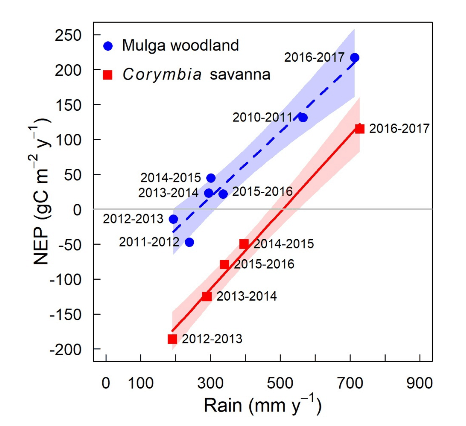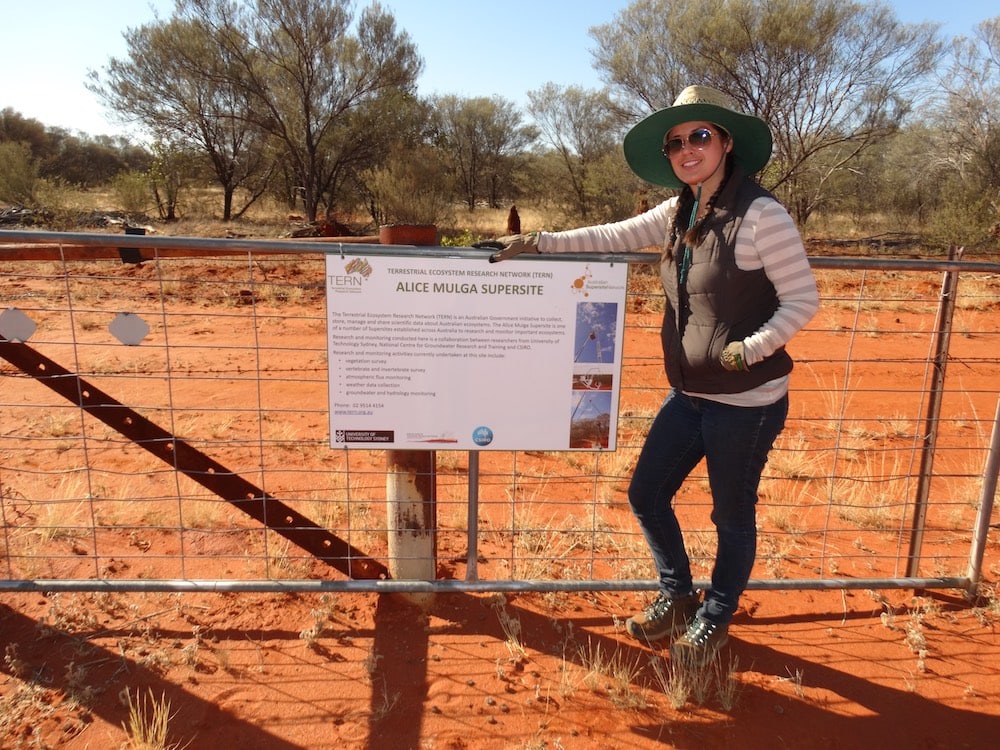New science using NCRIS-enabled TERN research infrastructure improves our understanding of the amount of rain our arid ecosystems need before they switch from being carbon absorbers to emitters. Read the latest environment monitoring findings that prove important for global carbon and water budgets and for modelling our future climate.
Arid and semi-arid regions occupy 70% of the Australian land surface and climate driven changes to the functioning of these regions have huge impacts on the global carbon budget. During wet periods, vegetation expands and more CO2 is stored—creating a carbon sink—but during dry periods, plants dieback and regions switch to becoming carbon sources.
The implications of such pivots are astounding. For example, research data collection from the 2011 la niña, shows higher than average rainfall in arid and semi-arid Australia significantly contributed to the southern hemisphere capturing more CO2 than it emitted and ‘the global carbon sink anomaly’ was coined.

How CO₂ budgets will change as dry periods become drier and wet ones wetter
Climate variability in central Australia is very large, ranging in rainfall from under 30 mm per year in the last couple years to over 950 mm per year in the mid-1970s. As IPCC projections for arid Australia indicate such extreme variation to continue, understanding these source to sink (and vice versa) tipping points, and being able to predict them, is of global importance.
To this end, a team of researchers from University of Technology Sydney has used long-term data collected at NCRIS-enabled TERN sites in two of arid and semi-arid Australia’s major biomes, Mulga woodlands and spinifex grasslands (Corymbia savanna). Research lead, Dr Tonantzin Tarin explains:
“Our research shows how two different ecosystems of central Australia responded to rain pulses between 2010 and 2017. We show how much rain is needed to switch an ecosystem from being a source of carbon to being a carbon sink.
In Mulga woodlands, annual rainfall of more than 262 mm per year makes it a carbon sink and for the spinifex grasslands the pivot point is 507 mm per year.”
That means that over the seven-year period, the Mulga woodland was a carbon sink for five years and the spinifex grassland for just one year. Dr Tarin adds that there is also significant seasonal, inter-annual variability and that the tipping points are linked to different climatic drivers such as temperature, soil water content and solar radiation.

Australia’s two iconic dryland ecosystems have very different carbon budgets
The research relied heavily on data from TERN’s Alice Mulga SuperSite together with data from the nearby Ti Tree site which has TERN OzFlux and NCRIS-enabled Groundwater project infrastructure, says Dr Tarin’s fellow researcher, Dr James Cleverly.
“Despite their close proximity, these two iconic Australian dryland ecosystems (hummock grasslands, Mulga) support very different carbon budgets in response to climate extremes, droughts, fire and flooding rains.
“Mulga’s lower pivot point suggests that the carbon sequestration potential of Acacia woodlands is much higher than for hummock grasslands, even when factoring in carbon losses due to drought and mortality.
This research provides a unique view on drylands and their impact on global carbon budgets, an understanding which would be lacking without NCRIS projects like TERN and Groundwater.”

Essential knowledge for climate adaptation, mitigation and modelling
“A better understanding of ecosystem productivity at a regional-scale will also improve ecosystem assessments of fire risk when evaluating fuel load based on available and detailed data within specific ecosystems.
This research will also go a long way in improving the accuracy of coupled climate models to provide advances in our knowledge that is central for decision makers in the management and understanding of landscape function.”
- To help celebrate the 20th anniversary of OzFlux—the TERN-supported Australian and New Zealand eddy-covariance flux research community—our ‘site of the month’ series will visit a new flux site each month to celebrate recent achievements, the people who work there and the uniqueness of the environment measured.
- Data from TERN’s Wombat Stringybark Eucalypt SuperSite and all other TERN Ecosystem Processes monitoring sites are openly available for download via the TERN Data Discovery Portal.







